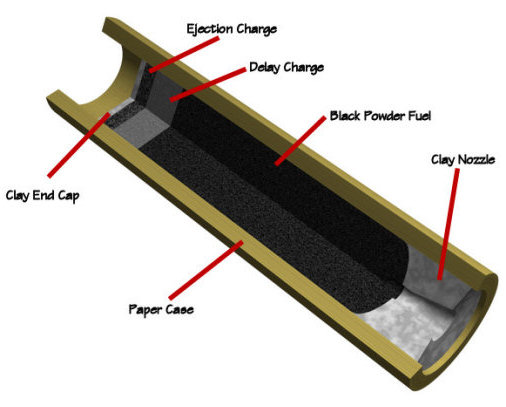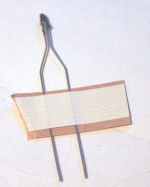If you have a question that you don’t see in any FAQ,
let us know, and we’ll try to answer it and add it to one of the FAQ’s.
The most common motor found in the hobby of Rocketry is the Estes black powder motor. These are very safe, reliable motors that almost everyone in the hobby has started out flying and many still fly. There is a separate FAQ for composite motors.
Below are the major parts of the motor.

During the motor burn there are several phases described below.
 |
Just after ignition there is little surface area so thrust is low. |
 |
But in less than 1/4 second there is much more surface area burning, so the motor now burns at peak thrust to boost the rocket off the pad quickly enough that the fins can work to stabilize the rocket. |
 |
Once the fuel burns to the casing it can only burn from end to end, so there is less surface area and therefore lower thrust. This allows the rocket to accelerate to its maximum velocity. |
 |
The delay charge is a different kind of fuel that burns more slowly and produces no thrust. But it does produce smoke to aid in tracking the rocket in flight. |
 |
Then the ejection charge fires to pressurize the rocket body and deploy the recovery device. |
Not shown in these images is the igniter. All model rocket motors are electrically ignited. We do not use fuses. This allows us to control when the rocket launches. We can stop the countdown at any point prior to pressing the launch button. On the other hand, once a fuse is lit you are committed. Using electrically fired igniters gives us much greater control over the launch. Never use fuses. Below are two common black powder motor igniters. The Estes igniter is on the left and the Quest Q2 igniter is on the right.


This figure illustrates the differences in motors that is reflected in the motor designation. All the motors shown below are type B6. See how the internal configuration of the motor is reflected in the motor designation.
 |
B6-4 A single stage motor has a delay about right for an average rocket powered by this motor alone. It contains an ejection charge to deploy a recovery device. |
 |
B6-6 An upper stage motor has a longer delay assuming that a booster will give it more speed than this motor working alone. This motor can also be used alone in a light rocket. |
 |
B6-0 A booster motor has no delay, ejection charge or clay cap. At the end of the propellant burn, it bursts through to ignite the next stage. |
 |
B6-0P This motor also has no delay or ejection charge. But it has a clay cap to prevent the burst at the end of the burn. It has special uses, but will not eject a recovery device on its own. |
There are several sizes in black powder motors. Theses are shown as Estes motors but Quest makes similar motors.

